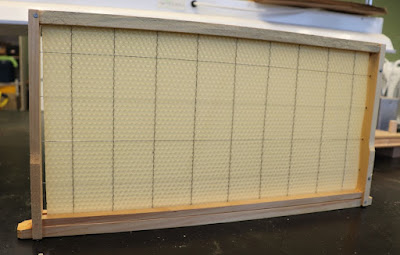Today we will wrap up our discussion of frames. It is clear that considerably more effort goes into preparing wax foundation frames compared to plastic. The reason that we have chosen to use wax is that, observationally, bees demonstrate a preference for such foundation and will draw out comb more readily. Quick production of wax by honey bees is useful as it is beneficial to refresh your comb periodically. We will explain this idea as we continue, now let’s begin!
Wax On Wax Off
The final steps in assembling our frame are to insert the wax and embed the wire. It is suggested that if the frame will be used for honey extraction, to use foundation with vertical wires for extra strength. Insert the foundation such that it weaves through every other line of wire and the top and bottom of the sheet lay in the grooves of the top and bottom bars. Replace the wooden cleat back in its original position, flush against the wax foundation, and use a hammer or a staple gun to drive four brads perpendicularly through the cleat, securing it once again to the top bar.
Now we will embed the wire into the wax. Bees prefer to feel wax rather than the metal wire and this will support them in producing uniform comb. There are safe and reliable tools available for embedding wire from local beekeeping supply stores. The principle is to heat the wires just enough to melt the surrounding wax and become encased. Commonly, beekeepers use a tool which passes a DC current through the wire, heating it and melting the wax around the wire. This is a quick, straightforward method but it is easy to overheat the wires, so be very cautious. Wires can also be pressed into the wax with an embedding tool. Basically, these are a spurred wheel which rolls along the wire to push it into the wax. Some of these tools also are heated to help with the process. With the wires embedded our frame is ready to enter a hive!
Once in the hive, the bees will begin building comb on the new foundation. Wax production is integral to all beekeeping operations whether beeswax is an economic output or not. It is necessary for growing hive numbers and comb rotation is a valuable component of integrated pest management (Pernal and Clay 2013). The Canadian Association of Professional Apiculturists suggests that brood comb only remain in an apiary for three to five years for optimal hive health. Chemical residues leftover from miticide treatments or brought into the hive from foraging activity can persist and accumulate in wax (Murcia-Morales et al 2022). Rotating new brood comb also improves colony productivity by allowing brood to develop into larger, more productive individuals (Taha et al. 2021). Each bee that develops within a cell leaves behind developmental material which, overtime, results in smaller cells and smaller bees. Check out our Comb Rotation ATTTA Factsheet for more information!
Connecting with ATTTA Specialists


